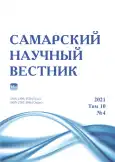Материалы по гнездованию рябинника Turdus pilaris (Linnaeus, 1758) (Aves, Passeriformes) в пойменных местообитаниях бассейна р. Абакан (Южно-Минусинская котловина)
- Авторы: Вейснер Т.В.1, Злотникова Т.В.1
-
Учреждения:
- Хакасский государственный университет им. Н.Ф. Катанова
- Выпуск: Том 10, № 4 (2021)
- Страницы: 19-23
- Раздел: Общая биология
- URL: https://journals.rcsi.science/2309-4370/article/view/104889
- DOI: https://doi.org/10.17816/snv2021104102
- ID: 104889
Цитировать
Полный текст
Аннотация
В данной статье приведены результаты многолетних наблюдений за гнездовой биологией рябинника в условиях Южно-Минусинской котловины. Наблюдения проводились на двух площадках в пойменных местообитаниях бассейна р. Абакан. Проведены сравнения с показателями гнездовой биологии вида в условиях Северо-Минусинской котловины, которые опубликованы. Рябинник строит гнёзда на всех видах древесных растений, которые встречаются в пойме. Сроки начала размножения Turdus pilaris в степной котловине варьировали от 20-х чисел апреля до первой пятидневки мая. Выявлены отличия в сроках размножения рябинника у популяций из различных высотно-поясных комплексов (степной и лесостепной). Отмечена разница в высоте расположения гнёзд на древесных растениях в зависимости от архитектоники кроны и на территориях с разной степенью беспокойства. Даны размерные характеристики гнёзд и яиц. Отмечена высокая внутрипопуляционная изменчивость размера яиц. Коэффициент вариации для большего и для меньшего диаметра составлял 11–13%. Полная кладка состояла из 4–6 яиц. Средняя величина кладки составляла 4,9–5,2 яйца. Отличий по средней величине кладки на разных территориях не выявили. Успешность гнездования в 2021 году была высокой (50–72%).
Полный текст
Открыть статью на сайте журналаОб авторах
Татьяна Викторовна Вейснер
Хакасский государственный университет им. Н.Ф. Катанова
Email: tashaveisner@gmail.com
студент Института естественных наук и математики
Россия, АбаканТамара Викторовна Злотникова
Хакасский государственный университет им. Н.Ф. Катанова
Автор, ответственный за переписку.
Email: tamara.zlotnikova@mail.ru
кандидат биологических наук, доцент, заведующий кафедрой биологии
Россия, АбаканСписок литературы
- Баранов А.А., Воронина К.К. Птицы интразональных лесных сообществ степной зоны Средней Сибири: монография / под общ. ред. А.П. Савченко. Красноярск: КГПУ, 2013. 212 с.
- Паевский В.А. О популяции рябинника Turdus pilaris в самом центре Санкт-Петербурга и о некоторых общих вопросах урбанизации птиц // Русский орнитологический журнал. 2010. Т. 19. С. 27–31.
- Демидова Е.Ю. Репродуктивные параметры четырёх видов дроздов Центральной Сибири // Известия РАН. Серия Биологическая. 2011. С. 593–602.
- Демидова Е.Ю. Жизненные циклы дроздов (роды Turdus, Zoothera) енисейской средней тайги: автореф. дис. … канд. биол. наук. М., 2012. 24 с.
- Герасимчук А.В. Экологические аспекты гнездования дроздов рода Turdus в условиях Чулымо-Енисейской котловины: автореф. дис. … канд. биол. наук. Красноярск, 2011. 24 с.
- Герасимчук А.В., Исматова Л.И., Бутаков Н.Г. Питание птенцов дрозда-рябинника (Turdus pilaris L.) в пойме р. Белый Июс (Ширинский район, Республика Хакасия) // Экология Южной Сибири. 2008. Т. 1, № 12. С. 71–72.
- Герасимчук А.В., Исматова Л.И. Гнездовая экология дроздов рода Turdus при симбиотопии в лесостепных районах Средней Сибири // Экология, эволюция и систематика животных: мат-лы всерос. науч.-практ. конф. с междунар. участием. Рязань: Голос губернии, 2009. С. 202–203.
- Герасимчук А.В., Степанов А.М. Питание дроздов рода Turdus в гнездовой период на территории Чулымо-Енисейской котловины // Вестник КрасГАУ. Сер. Экология. 2011. № 11. С. 147–151.
- Герасимчук А.В., Степанов А.М., Чеблоков С.В. Гнездовая экология дроздов рода Turdus при совместном обитании в лесостепных районах Средней Сибири // Вестник КрасГАУ. Сер. Экология. 2011. № 1. С. 98–103.
- Михеев А.В. Биология птиц. Полевой определитель птичьих гнёзд. М.: Цитадель, 1996. 460 с.
- Доржиев Ц.З., Дурнев Ю.А., Сонина М.В., Елаев Е.Н. Птицы Восточного Саяна. Улан-Удэ: Изд-во Бурятского госуниверситета, 2019. 400 с.
- Рябицев В.К. Птицы Сибири: справочник-определитель: в 2 т. Т. 1. М.–Екатеринбург: Кабинетный учёный, 2014. 483 с.
- Захарова Л.С., Яковлева М.В. Сезонная изменчивость величины кладки и успешности размножения рябинника Turdus pilaris в заповеднике «Кивач», Карелия // Русский орнитологический журнал. 1999. Вып. 71. С. 3–8.
- Кисленко Г.С. О биологии рябинника Turdus pilaris в Красноярском крае // Русский орнитологический журнал. 2020. Т. 29. С. 1624–1625.
- Малков Н.П., Малков В.Н., Ирисова Н.Л. Птицы семейства дроздовые Turdidae Республики Алтай (состояние изученности и дополнение к прежним публикациям) // Алтайский зоологический журнал. 2020. Вып. 16. С. 40–55.
- Рыжановский В.Н., Рябицев В.К., Гилёв А.В. Плодовитость воробьеобразных птиц (Passeriformes) Приобской лесотундры и полуострова Ямал // Экология. 2019. № 3. С. 217–225.
- Паевский В.А. Демография птиц. Л., 1985. 265 с.
- Головань В.И., Пчелинцев В.Г. Материалы по распределению, численности и гнездованию дрозда-рябинника Turdus pilaris на юге Ленинградской области // Русский орнитологический журнал. 2005. Т. 14. С. 495–500.
- Куранов Б.Д., Савельев С.В. Репродуктивные показатели и эмбриональные нарушения у рябинника (Turdus pilaris L.) в зоне влияния предприятий ядерно-топливного цикла // Экология. 2009. № 2. С. 116–121.
Дополнительные файлы











